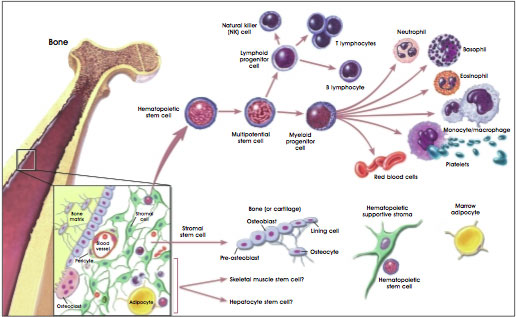|
~A Discussion on Bone Marrow Transplants~ Author: Kara Marina B. Sc. Biopsychology Located in your bone marrow, Hematopoietic stem cells eventually make the components of blood. Similar to embryonic stem cells, hematopoietic stem cells are categorized into four types: pluripotent, totipotent, multipotent or unipotent (1). Their potency depends on how far in their development they exist, whether they can become anything or just one type of cell. Unlike embryonic stem cells, hematopoietic cells can only differentiate into blood cells, but still the possibilities are vast. Sickle Cell patients require red blood cells be produced from their Bone Marrow Transplant (BMT). Leukemia patients require all of their blood components be replenished, each blood cancer arresting bone marrow cells at different stages. The best stem cell has a wide range of development possibilities: the pluripotent and the totipotent cells. Also, the best stem cells can regenerate themselves after they die. These long-term stem cells are sought after and hoped for while harvesting. Unfortunately, to date, there is no method to discern the difference between stem cells with longevity and cells dubbed short term-progenitor cells (2). These short term-progenitor cells may last four to five months.
Two theories surround the differentiation of bone marrow cells: the deterministic view and the stochastic view. The deterministic view contents that each cell becomes a product of its environment, changing in response to external signals such as hormones. The stochastic view contents that stem cells differentiate randomly. Is it random or is it fate? Research shows us both: random and fate. Totipotent Hematopoietic cells differentiate deterministically and therefore have the greatest ability to react appropriately to a new host’s needs. But each particular cell’s fate seems to be random within that environment even though the overall effect is determined by the host. In the end, there’s an order to their random, as seen over a long period of time. But only true stem cells can show us this glory: pluipotent or totipotent stem cells capable of self-renewal. Retrieving these cells makes the difference between a successful and a non-successful BMT, among other factors, namely having a great match! Fortunately, new ways of extracting stem cells are quickly replacing the old bone marrow needle routine. Because a small amount of stem cells circulate in the peripheral blood, researchers have found they can ‘coax’ the bone marrow cells from the bone marrow into the circulating blood by injecting a cytokine such as granulocyte-colony stimulating factor (3). Injected prior to harvesting, this procedure yields more Hematopoietic cells with better results! All the more reason to register….. Individuals wishing to register can: · call 1-888-236-6283 (1-888-2-DONATE) and ask about registering to be a bone marrow donor · create an account and with blood.ca (create username and password) and receive a mouth-swab kit by mail · Contact Kyshah Powell at: [email protected] for the September drive in Hamilton · Outside of Canada visit here. References 1. Murnagham, Ian. (2014). Stem Cells: The Facts. Explore Stem Cells. Retrieved August 27, 2014 from http://www.explorestemcells.co.uk/StemCellsFacts.html 2. Percorino, Lauren. (2012). Stem Cells for Cell-Based Therapies. Actionbioscience. Retrieved August 27, 2014 from http://www.actionbioscience.org/biotechnology/stem_cells_for_cell-based_therapies_article_update.html 3. National Institute of Health. (2011). Hematopoietic Stem Cells. In U.S. Department of Health & Human Services. Retrieved August 27, 2014 from http://stemcells.nih.gov/info/scireport/pages/chapter5.aspx#figure1
0 Comments
Leave a Reply. |
AboutThis section is solely to let our Sickle Soldiers tell their story trials & tribulations alongside things they feel are wrong in the Sickle Cell Community Archives
March 2016
Categories
All
|

 RSS Feed
RSS Feed
